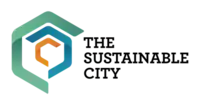The Sustainable City
The Sustainable City is a 46-hectare property development in Dubai, United Arab Emirates.
The Sustainable City | |
|---|---|
Community | |
 | |
| Coordinates: 25.0294°N 55.2784°E | |
| Country | United Arab Emirates |
| Emirate | Dubai |
| City | Dubai |
| Established | 2015 |
| Area | |
| • Total | 0.46 km2 (0.18 sq mi) |
| Population | |
| • Total | 2,700 |
| • Density | 5,900/km2 (15,000/sq mi) |
Situated on the Al Qudra Road, it is the first net-zero energy development in the Emirate of Dubai. The masterplans amalgamate green, energy efficient designs with a people-centric philosophy that includes nature and animals thus ameliorating public space. The development includes 500 villas, 89 apartments and a mixed-use area consisting of offices, retail, healthcare facilities, a nursery and food and beverage outlets. Phase 2 of the development will include a hotel, school and innovation centre.
The City was developed by Dubai-based Diamond Developers, whose Chairman, Faris Saeed, has stated that much of his inspiration for the development came from UC Davis West Village.
Key elements of the City include:
- a residential area of 500 townhouses and courtyard villas inspired by Dubai's old Bastakiya district
- 11 natural ‘biodome’ greenhouses, organic farm and individual garden farms for local food production that use a passive cooling method with fans and pads.
- 10 MW peak solar production
- waste water recycling, with segregated drainage for greywater and blackwater using papyrus as a biofilter
- biking and shaded jogging trails
- charging stations for electric cars
- an equestrian centre
- A sustainable school (Fairgreen International School)
- An autism center (Sanad Village)
- Short stay holiday homes (The Sustainable Homes)
- SEE Institute
Apart from periphery roads and car parking areas, the development is a car-free site.
The parking areas are topped by solar shading featuring solar panels that are connected to an electrical grid to supply energy into different sections of the city.
Panels are also placed on the roofs of all of the houses. The construction waste is reused to furnish the public spaces. The townhouses have UV reflective paint to reduce the thermal heat gain inside the houses.
References
- The Sustainable City - Gulf Sotheby's International Realty
- Dubai's Green City Kicks Off
- [ Sustainable City To Complete By 2015]
- Baharash Architecture
- UC Davis West Village Inspires Plan Dubai Sustainable City
- CW Awards 2016 - Sustainable Project Recognized
- Dr. Suad Joseph, University of California, Davis ,article
- UC Davis sustainability research collaboration